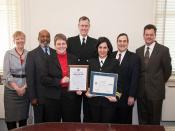FHRM Question one HRM theorists argue that employees are assets and not just costs!!! What is HRM? What exactly is 'human resource management'? Many people find HRM to be a vague and elusive concept, and the reason being that it seems to have a paradoxes of meanings and theories.
Human Resource Management (HRM) is an extension of the idea of personnel management, not so long ago, under personnel management, issues such as bonus schemes, personal matters, salaries and social matters, was the role of the personnel department.
However, under HRM, such matters are handled or delegated to line managers in all departments. Those that believe in the use of HRM argue that if workers are to contribute fully to the organisation, they must be developed on a personal and individual basis, such development is the responsibility of the line managers, who are excepted to bring out the best out of their workers.
HRM employs the techniques of strategic management for the deployment of human resources, it focuses on the organisation's, as a business concept, concern with achieving its main objectives, such as maximising profits and containing costs. HRM aims for a perfect relationship between the business overall objective and recruitment, performance assessment, reward management, development and dismissal.
Divergence and convergence of HRM theories.
Human Resource Management is a philosophy of people management based on the belief that human resources are uniquely important to sustain business success. An organisation gains competitive advantage by using its people as assets effectively; that is reached by using their expertise and ingenuity to meet clearly defined objectives. HRM is aimed at recruiting capable, flexible committed people, managing their performance and developing key competencies HRM approaches can be divided into two notions, "soft HRM " and "hard HRM", the soft HRM endeavours to treat employees as valuable resources whilst "hard" emphasises on quantitative, calculate and strategic aspects of a corporation.
The hard HRM is a view is associated with the Michigan Business School and the soft ides is echoed by the Harvard model theory.
The Michigan model has a hard perimeter, holding that employees are resources in the same way as any other business resource.
This philosophy is supportive of the perception that workers are a broad organizational requirement just like quality or efficiency. Personnel policies and organization structures have to be managed in a way that is fitting with the overriding organizational strategy, the organisation is considered effective where there is a tight lead between human resource and business strategies.
The Michigan theorists appreciate the importance of issues such as selection, performance appraisal, rewards and development and overlooks other subjects such as motivation factors Viewing employees as costs rather than assets belongs to the hard HRM section, however such concept contradicts the very principle of HRM as it seems rather naïve to think that workers are most productive when treated as resources which should be obtained cheaply, developed carefully, exploited as much as possible and only appreciated through remuneration, promotion and performance management. Therefore such concept does not compliment the general objective of the organisation which is to maximise profits through maximising production which could not be achieved if the workers are not being as productive as they could potentially develop into.
However, such concept is countered by theorists who belong to the soft HRM school of thought, who believe that workers are actually most productive when they are committed to the company, informed about strategy and trading conditions, involved in deciding how tasks are done, and grouped in teams that work without strict supervision. Such concepts are directly linked to modern motivation methods such as the Maslow's hierarchy of needs, it also bares a slight resemblance to McGregor's X and Y theories; as evidence builds that the Theory Y model of management, built on commitment and involvement, is far more successful in the workplace than the bureaucratic and authoritarian Theory X model.
The argument of treating workers as assets rather than cost is perfectly highlighted by the Harvard HRM Model, where employees are seen as being fundamentally different from other resources - they cannot be managed in the same way. Motivation of workers is seen to be achieved through delegated levels of authority, responsibility and power, such practise is believed to lead the organisation to achieving the 'four C's' from their employees: Commitment Congruence Competence Cost effectiveness In theory, by achieving the 4 Cs, the company should be meeting its business objectives as well as keeping its labour force motivated and satisfied which is the very principle of HRM.
The Harvard Model shows human resource policies to be influenced by two significant considerations: Situational factors in the outside business environment or within the firm such as laws and societal values and management philosophy. According to Beer et al these factors may constrain the formation of HRM policies but (to varying degrees) they may also be influenced by human resource policies.
Stakeholder interests, including those of shareholders, unions, government, management, employees. Beer et al argue that human resource policies SHOULD be influenced by ALL stakeholders. If not, the organisation will not be successful when it comes to meeting the needs of these stakeholders in the long run and it will fail as an establishment.
The Harvard Model principles argue that even though implementing such HRM strategies will not increase the profits of the company by a significant margin in the short run, it will improve all four Cs which will lead to favourable consequences for individual well-being, societal well-being, and organizational effectiveness in the long run which is the breed for a healthy institution.
According to 'Ichniowski et al (2000)' employees empowerment theory, by treating employees as assets, an organisation achieves two crucial consequences from their worker: 1) Working smarter. Innovative work practices can lead to improved efficiency. Workers can suggest improved work practices because they have a more intimate knowledge of the job than managers or external consultants. This process encourages rewarding high performance through collective bonuses.
This theory holds that workers are fundamental assets which can be productive, for example given emphasis to the following issues result in positive consequences: * Cross-training and flexible job assignment may reduce the costs of absenteeism.
* Delegating decision-making to self-directed teams can reduce the number of supervisors or middle managers and improve communication.
* Training in problem-solving, statistical process control, and computer skills may enhance the benefits of information technology.
* Involving workers and unions in decision-making can reduce grievances and other sources of conflict.
2) Working harder. People may work harder if they find elements of a job to be interesting or enjoyable, and this may come from rewards or feedback. They are also less likely to resent aspects of the job if have contributed to its design.
In practise, to treat workers like assets, businesses will need to be committed to subjects such as job enlargement, job enrichment, job rotation and team working. Also built into the principle of HRM is the idea that staff should be regularly appraised by their HR managers which means there will be regular meetings, in which the staff members' performance is analysed, normally against performance targets. As well as this measure of performance, training needs are discussed and career prospects examined. Within the staff appraisal interview, bonus earnings may also be decided upon.
The theorists argue that staff appraisal motivates, allows the setting of achievable targets, allows those who understand the job to give a value to the work done , and allows achievable bonuses to be earned. However, staff appraisal's critics believe that it creates tension between workers and allows line manager to manipulate as well as exploit workers.
To be successful appraisal systems must be based on clear criteria for appraisal, criteria are based on agreed and understood targets, managers must be trained to solve problems that can arise as a result of poor performance being indicated in appraisals, and employees must be encouraged to fully participate in the system which means talking about their problems, their own failings and discuss methods of resolving problems and improving performance.
Such openness from line managers and workers should allow the staff to feel more relaxed at the work place and become more productive.
In practise, HRM theories proposing the opinion of treating employees as assets are difficult to implement as they are likely to lead to costly procedures, and in order to accomplish such a thorough scheme an organisation will need to satisfy certain issues such as matching people and jobs, training, rewarding and motivating.
A sensitive issue that is linked HRM is staff minimisation, as HRM preaches for job enlargement and job empowerment which will naturally lead to the need for less workers.
Also areas such as training and developing workers constantly will lead to being a number of surplus workers which will consequently lead to redundancies. Redundancy is seen to be a bad PR practise by businesses and it can have a negative influence on companies' income, additionally, in theory, having an exceptionally motivated and a highly productive workforce will lead to a happy workforce which should be committed to work for the company for a long time, thus, companies recruitments will be concise, also a bad PR practise if the companies are not creating employment.
Implementing HRM techniques of the soft notion will lead to a radical change in viewing unions, as they will effectively be surplus to requirement, having line managers and workers working closely and integrating effectively will lead to domestic issues being resolved quicker and workers not needing collective bargaining power and settling for individual settlements.
In theory, all the mentioned issues should combine and lead to individuals achieving what they are capable of, and not by people being forced into roles and tasks which are designed to produce output.
This is echoed by Japan's success in industrial productivity and the organisation of work, as Japanese companies have shown that quality comes from a combination of outstandingly designed products and a shrewdly motivated work force, not so long ago there was cases of workers in Japanese factories actually sneaking into the workplace during weekends and holiday periods to help the company be productive. The Japanese emphasis on team-working and employee involvement in quality improvement has been an example of how to achieve business goals by implementing HRM theories supporting the deployment of workers as assets rather than costs.
In conclusion, one needs to appreciate that one can't hold a single HRM theory to be the righteous one, there are many theories preaching for similar changes through different channels, even though HRM theories may seem somewhat shallow and inconclusive to a certain extent, a business will need find the perfect balance when it comes to deploying and supervising their worker.
Workers obviously must be treated as assets, but the cost of the development and deployment should also be taken into account as minimising cost is a major objective of a company. HRM is a relatively new and only time will tell what the HRM baby will mature into and how⦠Bibliography Books: Title: Business Studies 3rd edition Author: Stephen Danks Title: Human Resources Management A Contemporary Approach Author: Ian Beardwell & Len Holden Title: Human Resources Management Author: D Thorrington, L Hall & S Taylor





